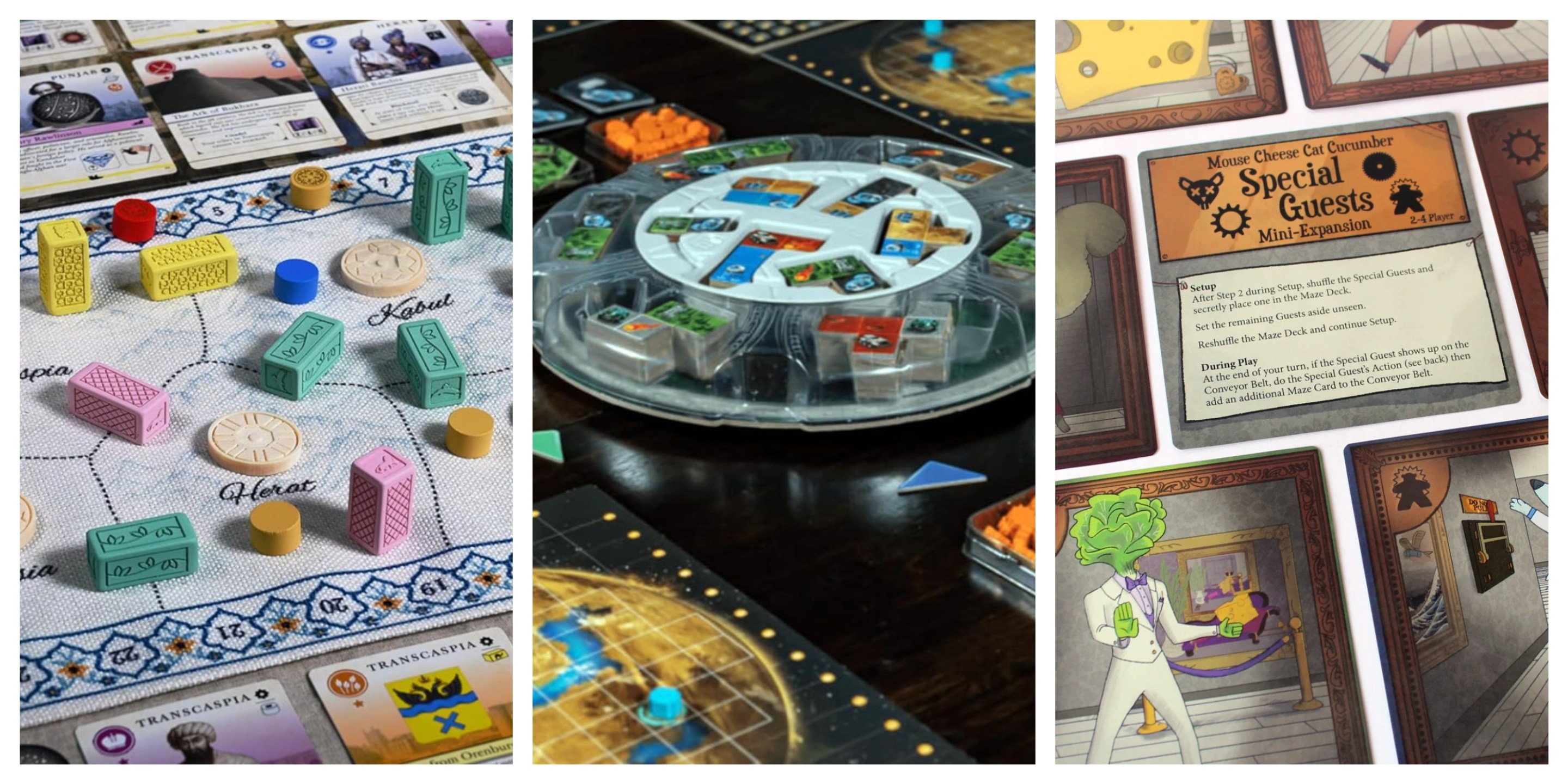The sign reads “OPEN” and the lights are on, but except for one clerk behind the register, Tower Games on Nicollet Avenue in south Minneapolis appears empty on a recent Tuesday evening. Listen up though, and you can hear voices from the back of the store, often intense murmurs, sometimes full laughter. That’s where the action is. It’s open game night.
Kay King is a woman with a big laugh and a gardenia behind her ear who presides genially over the affair, and she welcomes me as I try to slink into the room. At about a half-dozen tables, clumps of (mostly if not entirely) white (mostly if not entirely) guys are caught up in various games. Some are pretty expert level: One crew is embroiled in John Company, a complex historical game that involves the fate of the British East India company.
King is playing a much less challenging game of Spot, which, yes, is about dogs, with an older man named Richard, whose white beard and flopped red cap are suitably Dungeon Master-y. King describes him as something of a local legend and folks try to guess how many games he has at home. We’re all too low; he reportedly has 7,000.
This is my introduction to the world of tabletop gaming. Sure I drew my own Risk boards as a kid (it was a challenge to find people to play Roman Empire Risk) and, in the ’80s, was as into D&D as you’d expect someone of my age and limited social skills to be. But here I am a 54-year-old newb, and King goes easy on me. I’m introduced to a card game called Mojo, kind of a slightly advanced version of Uno. I lose the first game disastrously and but win the second handily.
An open game night like this is hardly unique in the Twin Cities metro. At shops across the region, similar groups gather, with Roseville, home of the massive Gamezenter and The Source Comics & Games, perhaps the hub of local gaming. (I won’t start naming other stores because I’d surely leave someone out, but you can find a list of them here.) And that’s not to mention the multiple conventions and meetups in town, or the annual Protospiel, where designers bring their newest wares or works-in-progress to be playtested by discerning gamers.
When I ask why gaming is such a popular pastime in Minnesota, I hear some variation on the obvious answer: “Winters here are cold and dark and long.” Maybe it’s that simple, maybe not. But Minnesota isn’t just packed with people who like playing games—it’s also become known for its game designers. A post on the forum Board Game Geek lists 25 game companies in the Twin Cities, ranging from international firms to smaller startups.
To learn more about the legacy of gaming in Minnesota, I spoke with three local designers. Cole Wehrle works at Leder Games, where he developed the massive bestseller Root, but he also publishes more niche historical games at Wehrlegig Games, which he runs with his brother. (Remember John Company, mentioned above? That’s one of his.) Seppy Yoon is the man behind Fight in a Box, which was founded in 2013. And Adam Rehberg, the CEO and namesake of Adam’s Apple Games, started his company in 2015.
“This is a weird little industry town,” Wehrle acknowledges.
The history of gaming in Minnesota stretches back to the ’60s, when the Minnesota Mining & Manufacturing Company, better known as 3M, produced games of strategy (TwixT), cut throat competition (Acquire) and trivia (Facts in Five) in handsome leatherbound editions. Then there are one-offs like Sequence, developed in the 1970s by Doug Reuter, the Eden Prairie Republican who served in the state legislature in the late ’90s.
The rise of role-playing games in the ’70s drove down board game popularity, but in that world Minnesota played an outsized role as well. Dave Arneson, a student at the U of M, was one of the original developers of Dungeons & Dragons, though he fell out with co-creator Gary Gygax after a stint in Wisconsin.
The rise of computer gaming had brought about an industry slump by the time St. Olaf grad Christian T. Petersen launched Fantasy Flight Games in 1995. After finding success with its own games like Twilight Imperium, Fantasy Flight began publishing successful D&D supplements and eventually landed the license for Star Wars-related games. Licenses for other massive franchises like The Lord of the Rings soon followed, and in 2014 FFG merged with the French company Asmodee.
Perhaps an even greater influence on the industry was another major company: Atlas Games, founded by a Carleton guy, John Nephew. Its role-playing game Ars Magica was an early hit, and many successful game designers passed through its doors.
“John Nephew really fostered a community of people, and those people ended up spawning more companies or going to work in other places,” Yoon says. He notes that among its employees was Jeff Tidball, a well-known game industry figure who would found Left Justified Games, and that Patrick Leder of Leder Games, the company that hired Wehrle, interned at Atlas.
Wehrle agrees that the proliferation of small gaming firms can be traced to Atlas Games. “They incubated a bunch of more game companies, little spin-offs, so there's just a lot of expertise in the area,” he says.
“The history of game development in the Twin Cities has everything to do with people helping other people into the industry, which is great,” Yoon says. “It's one of the reasons that I love the game industry.”
(Neither John nor his wife and Atlas co-owner Michelle was able to talk to Racket for this story—the company was crowdfunding for a “Definitive Edition” of Ars Magica. But I made sure he knew that people were saying nice things about him.)
While the older pathfinders in the industry tended to start young, often fresh out of college, many of the new entrepreneurs came into gaming as a second career. Adam Rehberg, for instance, was a packaging engineer by trade, a background that’s come in handy with Adam’s Apple Games.
“Part of what sets us apart is we really find unique components that deliver new gameplay,” he says. “Because I've walked the factories in China, I know how things are made and I’m like, yeah, I know they can do it. I’m never worried that this will never be manufacturable, so we're really pushing boundaries on components and ideas.”
And so Adam’s Apple’s first game, Brewin’ USA, used specially designed bottle caps. In Swordcrafters you build a 3D sword over the course of a game—not that this was an easy sell.
“People said this will never work, it's gonna fall apart. And then at the end of the game, my kid’s gonna swing it and it's gonna hit someone else and it's gonna really hurt or it's gonna just destroy the game,” he recalls. “But we had these tested up to 40, 50 players, and it's still really, really strong. It's sturdy to the point where I could probably have a sword juggler do his thing and it would still stay together.”
Wehrle strayed into the gaming world from academia, discovering a particular style of games while still in grad school. “They were almost like outsider art,” he says. “They were games that weren't just trying to be fun; they had arguments they were making. I mean, there was a designer who made this game about the origins of consciousness. It was this game where you were kind of unlocking little corners of the brain. I started thinking about game design, and by the time I finished my graduate degree, the games that I worked on were doing much better than anything I published.”
Wehrle moved to Minnesota in 2017 sight unseen after a job offer from the newly launched Leder Games. “Patrick had made some profit for the first couple print runs of Vast, and he could have chosen to buy a little lake house in Minnetonka, but instead he hired a bunch of people,” Wehrle says. “He created a bunch of full time positions. And this is an insane thing to do.”
Leder began developing games in-house with its paid staff, rather than following the traditional game-development model, which is similar to book publishing: The creatives sign contracts, the company puts up the capital and ensures distribution. As Wehrle says, “You're not putting an author on salary, right?”
But as a staff developer at Leder, Wehrle quickly earned his keep with the wargame Root, which sold a half-million copies, putting it among the top five biggest games of recent years, he estimates. Leder has since published 11 “expansions” that allow you to play new variations on the game.
With a winner under his belt, Wehrle was ready to get ambitious. His next design was Oath, a game which… well, maybe I’d better let him describe it.
“Oath is a game built around a really simple concept: The game remembers how it's played,” he tells me. “It’s like you're playing a game of Risk, except at the end of the game, the game state is actually the start state of the next game. So it's sort of a game about how history gets told.”
For Oath to work, though, Wehrle had to address a basic fact of game play. “Games are little engines of entropy, and as you play them, they spend out their energy,” he says. He uses chess as an example: At the end of a game, few pieces are generally remaining. You can’t really start over from there.
To create Oath, Wehrle says, he had “to build in systems where the game can rejuvenate itself as it's being played, without it becoming repetitive. If the game is developing in interesting ways because of which pieces you took and where, then it's telling this bigger story.”
Wehrle has a historian’s fascination with how stories get told, an interest he really gets to explore with Wehrlegig Games. The company’s website even has an “essays” section, where the designer discusses postcolonialism, orientalism, and other topics as they play out in his games John Company and Pax Pamir, which is set in 1820s Afghanistan.
And Sappy Yoon? He’d been designing games for most of his life, but he didn’t go pro until 2013, when he left his job as a marketing director for a software developer to start Fight in a Box.
“My ex-husband and I had an agreement—I let him take three years off and then after his three years off, it was my turn,” he says. “And so instead of taking that time off, I decided to start my own game company and I've been doing it ever since. I know I'm not good at classic time off.”
Their first big-box game, End of the Line, was a hit locally, and they’ve expanded from there. It’s part of what Yoon calls their “post-apocalyptic series,” their “fashionverse” (a bit more on that later) and their animal steampunk series, which includes the relatively simple Squirrel or Die (“you have to survive winter as a squirrel in the world's most dangerous backyard”) as well as the more intricate maze-building strategy game Mouse Cheese Cat Cucumber.
Though he’s still got a side-hustle as a consultant, Yoon is happy with what he calls his “post-adult” life as a designer. “I've been a lot of places. I was kicked out of the Navy under ‘Don’t ask, don't tell.’ I ran a queer publication in the Twin Cities that had 10,000 readers in the ’90s,” he says. “I really feel like the game industry, people are my people.”
Fifteen years ago, or thereabouts, the tabletop gaming industry changed. Prior to that, says Wehrle, “You had big game publishers who were not really listening to their fans, big publishers who were pretty sure they knew what people wanted.” That created a market gap that creative little guys were ready to fill. All they needed was a little bit of money—you can produce a simple game for as little as $50K.
Then they found a way to get it. “The game industry dramatically changed with the advent of crowdfunding,” Wehle explains. “It’s as close to free capital as you can get, because you're giving me a little microloan, and I'm giving you a game six months before its retail release.”
But crowdfunding not only lowered the barrier to entry for game publishers—it made potential players an active participant in the game development process. Publishers set up multiple opportunities to “play test,” where gamers get a hands-on opportunity to evaluate a game-in-progress. And that audience tends to be articulate and quite explicit about what it wants and why.
“Crowdfunding really is an opportunity for brutal direct feedback before the thing’s a reality,” Rehberg says. “People will kind of poke holes in your argument or your ideas or your graphics. And they really will push you to raise the bar. We go back and actually make changes to the project based on what the crowd is seeing.”
And those gamers don’t pull punches. “The most harsh feedback I ever got was at a Protospiel,” Yoon says. “This guy had played End of the Line. And he looked at me and he said, ‘I think I like this game. It's you I don't like.’ And every time we came back around the table to him, he doubled down on some detail about me justifying why he hated me.”
In retrospect, Yoon can see this as a valuable learning experience. Design is only part of the business. Listening to gamers can be just as important as making a cool new game. “Play-testing is a skill. Community-building is a skill,” he says. You’re not just conducting a business transaction; you’re creating a relationship.
In some ways, that relationship grows out of internet forum culture. On the site Board Game Geek, gamers share opinions and information but they also wax theoretical about what makes a game good. “I got my start in this hobby by participating in those forums,” Wehrle explains. "When nobody really knew who I was, I wrote a series of designer diaries that kind of had a viral moment in the community that helped raise the money we needed.”
But at a most basic level, Rehberg says, “crowdfunding forces you to find your advocates and evangelists,” and those are necessary figures in a business driven by word of mouth.
The process has also taught Rehberg how large niches can be. “So many people reach out about the oddball games that we've done and all the sudden it's like, their favorite game,” he says. As an example he offers the Adam’s Apple game Four Humors, in which you play as a physician in the Middle Ages. “We’ve had people say, ‘I'm a doctor or I'm a psychologist, and I was looking for something about medieval medicine and thank you for this.' It's kind of wild to hear people say things like that but it happens more often than you think.”
And for all the benefits of play-testing, Wehrle confesses to a secret strategy for discovering if a game is working. “If I have one core rule, it's this: If you want to know what people think about a game, just listen to them talk about the game when they're not playing it,” he says. “And if they're telling the kinds of stories that you wanted your game to tell, then the game is working.”
Since these developers have been so generous with their time, it’s only fair that I give ’em a chance to plug their new products.
Fight in a Box is releasing a second edition of End of the Line. They’re also currently readying Conquest Princess: Fashion Is Power, set to be released in November.
The latter is a game in which, per Yoon, “We use the power of fashion and friendship to overcome galactic tyranny. We've got a little Barbarella, a little bit of Linda Carter's Wonder Woman, some Sailor Moon and we've got an unapologetically gay game designer… and then thus, you make a game which features all female or nonbinary main characters.”
He adds, “Also it’s just mind-meltingly hard.”
Wehrlegig is planning to introduce its latest historical game, Molly House, which centers on queer British culture in the 18th century. It’s named for the spaces gay and gender-nonconforming folks gathered at the time, before they were run down by a zealous citizens group called the Society for the Recognition of Manners. You basically try to throw parties without getting busted. It’s Wuhrle’s first time collaborating with an outside designer, Jo Kelly.
Wehrle has also been toying with a game about Reconstruction for years, and thinks he’s close to solving the problems with making such an ambitious project a reality. And his reading of Robert Caro’s classic study of New York public works titan Robert Moses, The Power Broker, has him wondering if it’s possible to create a game about municipal services.
I run into Kay again at Open Streets Nicollet, where she’s blowing bubbles to attract attention to Tower Games’ booth. They’ve got a walk-up D&D stand, where a few kids are flexing their roleplay imaginations. “I think all my guys are dead,” one laments. “I raise my weapon and I’m ready to fight,” boasts another. Maybe one of them will design the next Oath, or Conquest: Princess, or Brewin' USA—or maybe they’ll fund it, play it, and debate about it online. If they stay in the Twin Cities, there’ll definitely be a place nearby to participate.







